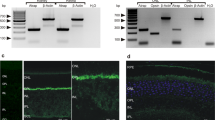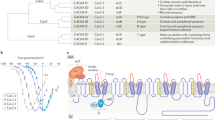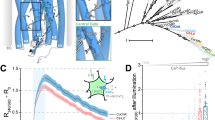Abstract
IT has been proposed that the regulation of the ionised calcium concentration inside many excitable and non-excitable cells is mediated by a Na–Ca countertransport mechanism where the Na electrochemical gradient provides the energy to maintain low levels of intracellular Ca2+ (refs 1, 2). Two recent observations, however, provide evidence consistent with the idea that Ca extrusion in squid axons is mediated, at least in part, by an ATP-driven Ca pump of the type observed in red blood cells3,4. First, in the absence of a Na gradient across the membrane there is an ATP-dependent ‘uphill’ extrusion of Ca which persists in the absence of external Na, Ca and Mg (ref. 3). And second, in Ca-injected unpoisoned axons, 50–90% of the Ca efflux can occur as an ‘uncoupled’ flux—that is, Ca efflux not accompanied by the uptake of Na, Ca or Mg (ref. 5). The existence of two apparently separate mechanisms for Ca transport, Na–Ca exchange and an ATP driven Ca-pump, raises the question of whether, in normal conditions, both mechanisms participate in the maintenance of the physiological pCa. To be of any use in controlling the pCa of the nerve, the mechanism responsible must be able to operate at normal Ca2+ concentrations, <10−7 M (ref. 6). We now present evidence showing (1) that in squid axons with physiological levels of Ca2+i most of the Ca efflux can be accounted for by an ATP-dependent system with high affinity for Ca2+i and ATP and which can operate in the complete absence of external Na and Ca; and (2) that a Ca transport mechanism with a low affinity for Ca2+i and ATP and extremely sensitive to Nai, Nao and Cao can contribute substantially to the total Ca efflux only at Ca2+i well above the physiological Ca2+ concentrations.
This is a preview of subscription content, access via your institution
Access options
Subscribe to this journal
Receive 51 print issues and online access
$199.00 per year
only $3.90 per issue
Buy this article
- Purchase on Springer Link
- Instant access to full article PDF
Prices may be subject to local taxes which are calculated during checkout
Similar content being viewed by others
References
Blaustein, M. P. & Hodgkin, A. L. J. Physiol., Lond. 400, 497–527 (1969).
Baker, P. F. Prog. Biophys. molec. Biol. 24, 177–223 (1972).
DiPolo, R. Nature 274, 390–391 (1978).
Schatzmann, H. J. Experientia 22, 364–368 (1966).
Baker, P. F. & McNaughton, P. S. J. Physiol., Lond. 276, 127–150 (1978).
DiPolo, R. et al. J. gen. Physiol. 67, 433–467 (1976).
Brinley, F. J. & Mullins, L. J. J. gen. Physiol. 50, 2303–2331 (1967).
Beaugé, L. A. & DiPolo, R. Nature 271, 777–778 (1978).
DiPolo, R. J. gen. Physiol. 73, 91–113 (1979).
Mullins, L. J. in Membrane Transport Processes Vol. 2 (eds Tosteson, D. C., Ouchinnikov, Y. A. & Latorre, R.) 371–381 (Raven, New York, 1978).
Robinson, J. D. Archs Biochem. Biophys. 176, 366–374 (1976).
Author information
Authors and Affiliations
Rights and permissions
About this article
Cite this article
DIPOLO, R., BEAUGÉ, L. Physiological role of ATP-driven calcium pump in squid axon. Nature 278, 271–273 (1979). https://doi.org/10.1038/278271a0
Received:
Accepted:
Issue Date:
DOI: https://doi.org/10.1038/278271a0
This article is cited by
-
Painful Nerve Injury Increases Plasma Membrane Ca2+-ATPase Activity in Axotomized Sensory Neurons
Molecular Pain (2012)
-
In the squid axon Na+/Ca2+ exchanger the state of the Cai-regulatory site influences the affinities of the intra- and extracellular transport sites for Na+ and Ca2+
Pflügers Archiv - European Journal of Physiology (2008)
-
Sodium/calcium exchange regulates cytoplasmic calcium in smooth muscle
Pflügers Archiv (1994)
-
Phosphate depletion impairs insulin secretion by pancreatic islets
Kidney International (1991)
-
Fine structural localization of Ca2+-ATPase activity at the frog neuromuscular junction
Journal of Neurocytology (1988)
Comments
By submitting a comment you agree to abide by our Terms and Community Guidelines. If you find something abusive or that does not comply with our terms or guidelines please flag it as inappropriate.



